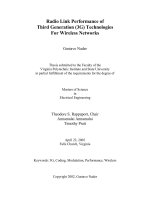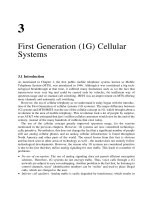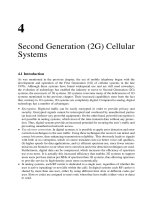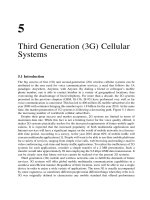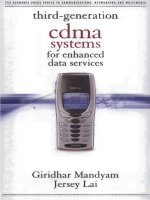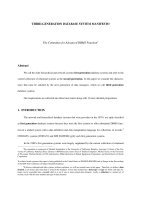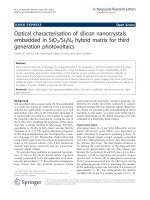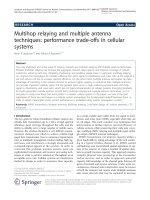Third Generation (3G) Cellular Systems
Bạn đang xem bản rút gọn của tài liệu. Xem và tải ngay bản đầy đủ của tài liệu tại đây (501.06 KB, 38 trang )
5
Third Generation (3G) Cellular
Systems
5.1 Introduction
The big success of first (1G) and second-generation (2G) wireless cellular systems can be
attributed to the user need for voice communication services, a need that follows the 3A
paradigm: Anywhere, Anytime, with Anyone. By dialing a friend or colleague’s mobile
phone number, one is able to contact him/her in a variety of geographical locations, thus
overcoming the disadvantage of fixed telephony. For more than a decade, the 2G systems
presented in the previous chapters (GSM, IS-136, IS-95) have performed very well as far
voice communication is concerned. This has led to 400 million 2G mobile subscribers for the
year 2000 with estimates bringing this number up to 1.8 billion for the year 2010. At the same
time, the market penetration of 1G systems is following a decreasing path. Figure 5.1 shows
the increasing number of worldwide cellular subscribers.
Despite their great success and market acceptance, 2G systems are limited in terms of
maximum data rate. While this fact is not a limiting factor for the voice quality offered, it
makes 2G systems practically useless for the increased requirements of future mobile appli-
cations. It is expected that the increased popularity of both multimedia applications and
Internet services will have a significant impact on the world of mobile networks in a foresee-
able time period. According to a survey, in the year 2010 about 60% of mobile traffic will
concern multimedia applications [1]. People will want to be able to use their mobile platforms
for a variety of services, ranging from simple voice calls, web browsing and reading e-mail to
video conferencing, real-time and bursty-traffic applications. To realize the inefficiency of 2G
systems for such applications, consider a simple transfer of a 2 MB presentation. Such a
transfer would take approximately 28 min employing the 9.6 kbps GSM data transmission. It
can be clearly seen that future services cannot be realized over the present 2G systems.
Third generation (3G) mobile and wireless networks aim to fulfill the demands of future
services. 3G systems will offer global mobile multimedia communication capabilities in a
seamless and efficient manner. Regardless of their location, users will be able to use a single
device in order to enjoy a wide variety of applications. The term 3G is usually accompanied
by some vagueness, as sometimes different people mean different things when they refer to it.
3G was originally defined to characterize any mobile standard that offered performance
quality at least equal to that of ISDN (144 kbps). 3G systems will provide at least 144 kbps for
full mobility applications in all cases, 384 kbps for limited mobility applications in macro-
and microcellular environments and 2 Mbps for low mobility applications particularly in the
micro- and picocellular environments. Those speeds are enough for the support of future
mobile multimedia applications. Returning to the example of the previous paragraph, the
presentation transfer would take only 8 s over the 2 Mbps link of a 3G system, which results in
a significant performance improvement over 2G. It should be noted that speeds similar to
those of ISDN are offered by some of the 2.5G standards presented in earlier chapters (GPRS,
IS-95B). However, these speeds occur under ideal channel conditions and only match the
lower speeds of 3G systems. Some key characteristics of 3G systems are [2]:
†
Support for both symmetric and asymmetric traffic.
†
Packet-switched and circuit-switched services support, such as Internet (IP) traffic and
high performance voice services.
†
Support for running several services over the same terminal simultaneously.
†
Backward compatibility and system interoperability.
†
Support for roaming.
†
Ability to create a personalized set of services per user, which is maintained when the user
moves between networks belonging to different providers. This concept is known as the
Virtual Home Environment (VHE) [3]
.Standardization for 3G systems was initiated by the International Telecommunication Union
(ITU) in 1992. The outcome of the standardization effort, called International Mobile Tele-
communications 2000 (IMT-2000), comprises a number of different 3G standards. Each of
these standards was submitted by one or more national Standards Developing Organizations
(SDO). The plurality of standards aims to achieve smooth introduction of 3G systems so that
backward compatibility with existing 2G standards is maintained. In order to facilitate the
development of a smaller set of compatible 3G standards, several international projects were
created, such as the Third Generation Partnership Proposal (3GPP), and 3GPP2. According to
Wireless Networks152
Figure 5.1 Number of cellular subscribers worldwide (Source: UMTS Forum)
the country of deployment, a suitable radio access standard (also known as the air interface)
has to be selected, in an effort to provide backward compatibility with existing legacy 2G
systems and conform to the country’s spectrum regulation issues. As explained in a later
section, spectrum assignment for 3G networks is a troublesome activity due to the fact that
spectrum is not identically regulated in every country.
The aim of 3G networks is towards convergence. 3G services will combine telephony, the
Internet and multimedia services into a single device. It is interesting to note that when the
first recommendations for 3G networks were made back in 1992, the Internet was still a tool
for the academic and technical society and multimedia applications were much simpler than
those of the present day. As a result, the need to support Internet and multimedia was not
directly identified in those days. However, this has changed over the years and the present 3G
standards will provide efficient support for advanced Internet services like web-browsing and
high performance multimedia applications.
5.1.1 3G Concerns
In order to enable the market penetration of 3G data services, pricing schemes that are flexible
and appealing to the consumer should be adopted. This, however, poses a problem for the
service providers. Data applications, especially multimedia ones, are bandwidth hungry. As
the bandwidth is a scarce resource, offering spectrum-demanding data applications will
impose a significant cost for the service providers. Thus, pricing schemes that are appealing
to both the user and operator communities need to be identified.
As far as battery technology is concerned, it is desirable to have long-life batteries. This
results in less maintenance activities (such as recharging) for the user. For 3G data services,
the need for increased battery life is even more significant since call durations will be much
higher for data than for voice services. However, battery technology improvements occur in
small steps. On the contrary, the energy efficiency of new electronics and software shows a
significant increase. As a result, the development of more energy efficient electronics and
software is desired in order to extend 3G terminal operating times between recharges.
The standardization of APIs for 3G applications will offer the ability to efficiently create
3G applications. Such APIs will allow the abstraction of both the terminal and network,
providing a generic way for applications to access 3G services. 3G APIs will enable the
rapid use of 3G services, allowing the same application to be used on a wide variety of
terminal types.
3G data services will need the development of intelligent new protocols. Most of the
protocols used today over wireless links are the same as those used over the wire. However,
such protocols do not perform optimally in the wireless environment. Middle-ware protocols
try to combat the defects of the wireless link, removing this burden from applications and thus
reducing application complexity. The development of efficient middle-ware protocols will
significantly improve application performance over 3G systems.
However, applications still need to contain added intelligence. When moving to a location
with bad connection quality, the link offered to the user will be inferior in terms of capacity.
Applications should posses the intelligence to adapt to such situations by lowering quality or
shutting down certain features. For example, a teleconferencing application could compen-
sate for the reduced capacity offered by either initiating a compression increase or shutting off
the video feeds.
Third Generation (3G) Cellular Systems 153
Another issue regarding intelligence is the ability to create a personalized set of services
for each user, which is available at all times. This concept is known as the Virtual Home
Environment (VHE). The VHE allows a user to personalize the set of services he has
subscribed to and tries to support these services when the user roams between networks of
different providers. If the user is using an application but is roaming to a network that does not
support it, the VHE will service him by using the application closest to his needs. For
example, consider a user that usually exchanges voice mail with his colleagues. The user
is on a business trip, which triggers roaming between two networks of different providers. It
would be of great benefit to him if the provider of the network he just roamed to offers support
for voice mail. However, if this is not possible, the VHE will convert the voice mail messages
to text messages and vice versa in an effort to provide support for the voice mail service.
Furthermore, it would be desirable to develop intelligence for the transfer of application
states between different terminals. Consider a user of a videoconferencing application.
Suppose that the user decides to leave his office in the middle of an ongoing conference,
still wanting, however, to participate in the conference while driving to home. It would be
nice for him to have the ability of seamless transfer of the videoconferencing application from
his computer screen to his mobile phone upon leaving his office. This transfer could take
place either directly between the two devices, or through built-in network intelligence.
3G multimedia applications will comprise several video and audio feeds. Returning to the
example of the previous paragraph, the ability to seamlessly transport the multimedia feeds of
the videoconferencing application among various types of networks (LAN at the office, 3G
while driving) will be of significant importance since the properties of various networks may
have an impact on the content. A single multimedia session should be served efficiently using
a combination of different networks, such as 3G, Ethernet, ATM and X.25.
5.1.2 Scope of the Chapter
The remainder of this chapter provides an overview of the 3G area. In Section 5.2, spectrum
regulation issues are examined and the need for additional spectrum is identified. The several
candidate extension bands are presented followed by a number of technologies that can
alleviate problems attributed to nonuniform worldwide spectrum regulation and spectrum
shortage. Section 5.3 begins with a brief explanation of the difference between services and
applications and presents the main service classes that will be offered by 3G networks from a
capacity point of view. This section also presents some representative 3G applications.
Standardization projects and issues, the three 3G air interface standards and the use of
ATM and IP technology in the fixed network are discussed in detail in Section 5.4. The
chapter ends with a brief summary in Section 5.5.
5.2 3G Spectrum Allocation
5.2.1 Spectrum Requirements
ITU plays an important role in spectrum regulation. ITU licensed a guideline for worldwide
IMT-2000 spectrum usage in parts around the 2 GHz band. It would be ideal if every country
in the world would follow the ITU guideline. All 3G systems would operate in the same
frequency band, a fact that would greatly ease global roaming, especially among operators
Wireless Networks154
following the same IMT-2000 standard. However, the national communications organiza-
tions are not bound to follow the ITU guideline exactly. A globally unique spectrum alloca-
tion is impossible since most countries have populated the frequency spectrum in different
ways according to their needs.
The only country that has exactly followed the ITU guideline is China. Europe and Japan
did not fully adapt to the guideline, as part of the IMT-2000 spectrum was already being used
for cordless devices and GSM. To make things worse, the entire range of the IMT-2000
spectrum is already in use in America by Personal Communication Services (PCS) and
cordless devices. Figure 5.2 shows the current state of spectrum allocation for some of the
most economically advanced countries in the world, which have not adapted to the ITU
spectrum regulation guideline.
Although in many cases the spectrum proposed by ITU for IMT-2000 is already in use, it is
still possible to offer 3G services over the spectrum bands now designated for 2G networks.
Some of the 3G standards that are covered later were developed with this approach in mind.
In general, we can expect to see two trends followed by 3G operators [4]:
†
In countries with parts of the IMT-2000 spectrum partially or fully in use, a migration path
will probably be followed by gradually offering 3G services over the spectrum allocated to
2G.
†
In countries where the IMT-2000 spectrum is unused, operators will be allocated new
spectrum bands, either paired or unpaired, to deploy their 3G systems.
If the predictions of analysts become true, the evolution and market penetration of 3G mobile
networks will lead to a huge number of subscribers and a big traffic increase. The spectrum
initially allocated to 3G networks will not be able to support the increased traffic [5], thus new
bands will have to be made available for use with 3G networks. The exact bands where this
spectrum will be allocated are not yet known, however, the following alternatives are under
consideration [6]:
Third Generation (3G) Cellular Systems 155
Figure 5.2 Spectrum allocation
†
470–806 MHz. Better known as UHF, these frequencies are currently used almost world-
wide for analog television broadcasting. Replacement of the analog broadcasting by
digital television, which will offer better spectrum efficiency and frequency reuse, may
offer the possibility of reusing parts of this band for IMT-2000 services. A benefit of this
band is its potential for almost worldwide allocation for IMT-2000. Furthermore, its
relatively low frequency provides support for long-range coverage, which is beneficial
in cases of sparsely populated areas. However, the transition to digital television is unli-
kely to be completed before 2010.
†
806–960 MHz. The lower part of this band is already used for television broadcasting.
Above 862 MHz this band is used for 2G systems such as GSM. Benefits of this band are
the same as those of the previous one (potential for global availability, long-range cover-
age). On the other hand, apart from television broadcasting, counties using GSM will face
additional problems. The GSM part of the whole band will be allocated for IMT-2000 only
in the longer term so the spectrum issue will not be solved in the near future. Furthermore,
using the GSM spectrum part for IMT-2000 in Europe will not alleviate the problem of
obtaining new spectrum for IMT-2000.
†
1429–1501 MHz. This band is used for several different services over the world. In
particular, satellites and terrestrial digital audio broadcasting use the part from 1452 to
1492 MHz. In Japan, a large part of this band is currently used for 2G systems with the
prospect of allocating it for IMT-2000 in the future. This band is considered as an exten-
sion band outside of Europe.
†
1710–1885 MHz. Some parts of this band are already in use by existing mobile systems.
Such is the case with GSM1800 in Europe. Other parts are used worldwide for air traffic
control. A benefit of this band is that it is already a nearly global mobile allocation near the
IMT-2000 spectrum. However, the band will be turned over for sole IMT-2000 use only
after 2G system operation is discontinued. Furthermore, since already in use by cellular
systems, this band does not solve the problem of additional spectrum for 3G cellular use.
†
2290–2300 MHz. This is a very small band used by about ten stations worldwide for deep
space research. In order to use it for 3G systems, coordination with those stations will have
to be achieved with separation distances between them and 3G stations of up 400 km. If
used for 3G, this band will probably be combined with the adjacent 2300–2400 MHz band.
†
2300–2400 MHz. This band is currently used for fixed services and telemetry applications.
It benefits by being close to spectrum already allocated to IMT-2000 and being wide
enough to offer sufficient additional spectrum for 3G. However, interference problems
with current services populating the band need to be solved.
†
2520–2670 MHz. This is the most probable candidate for additional band globally. It is
currently used by several countries for broadcasting applications and fixed services, never-
theless the majority of such applications are deployed in the United States. Benefits of this
band are its sufficient width and thus support for increased additional capacity.
†
2700–2900 MHz. This band is used for radar systems, satellite communications and
aeronautical telemetry applications. Although the width of this band is sufficient, deploy-
ment of radio navigation and meteorological radar systems is expected to increase in the
future, making global use of this band for IMT-2000 difficult.
From the above discussion, it can be easily concluded that differences in IMT-2000 bands
among different countries cannot be avoided. In order to enable roaming between (i) 3G
Wireless Networks156
service providers that use different standards and (ii) countries with providers using the same
3G standard but different spectrum bands, a 3G handset will have to support a number of
different standards and operating frequencies. This fact results in a significant difficulty and
thus cost increase in the manufacturing process of 3G handsets. A possible solution to this
problem is the concept of software-defined radio. This, along with a number of other enabling
technologies that can alleviate problems originating from spectrum shortage, are briefly
presented in the next section. Although most of these technologies are still in their early
stages, they are believed to be of significant potential for the performance improvement of
mobile wireless networks [5].
5.2.2 Enabling Technologies
5.2.2.1 The Need for 3G-handset Flexibility: Software-defined Radios
The Software-Defined Radio (SDR) concept [5,7,8] can provide an efficient and relatively
inexpensive means to manufacturing flexible handsets. Current 2G products implement digi-
tal technologies for the air interfaces in hardware. As a result, most of them can operate using
only a single standard or frequency. The diverse range of cellular standards and operating
frequencies, however, often frustrate users who lack the ability to roam between different
network types without significant adjustment, or even replacement, of their handsets. SDR
offers a potential solution to this problem. SDR is based on a common platform that can be
fully re-programmed or modified by downloading software over the air. This is different from
the seemingly similar functionality of some present handsets. In these cases, several standards
are hardwired into the device and standard activation is made over the air.
The adoption of the SDR idea is enabled by the technology evolution and market accep-
tance of general purpose Digital Signal Processors (DSP). The performance and manufactur-
ing costs of devices based on software or firmware driven re-programmable DSPs reach that
of conventional devices implementing functionality in hardware using Application Specific
Integrated Circuits (ASICs). The Software-Defined Radio Forum [9] is closely working with
3GPP to enable the use of SDR technology in 3G products.
However, the acceptance of SDR faces significant problems too. The most important are
outlined below [5]:
†
Implementation using ASICs is a mature technology. When facing the SDR idea, hard-
ware-based solutions may prove to be more cost efficient. This is especially true in cases of
products like base stations and infrastructure systems in general, which will probably be
used only inside a single network. Most of the time such products will not need to possess
the flexibility to support different standards and bands. Without the use of SDR technol-
ogy, such systems can be manufactured at a lower cost using ASIC technology. The same
may hold for mobile terminals. A significant number of cellular users will remain most of
the time under the coverage of the same provider and will thus infrequently, or never, need
the flexibility of easy roaming between providers using different standards and bands. As a
result, such users can choose a cheaper terminal based on ASIC technology.
†
As far as energy consumption is concerned, programmable DSPs tend to consume more
energy than ASICs. This is a problem for SDR technology considering the fact that
advances in battery life are not made at significant rates.
†
SDR-based implementations tend to produce terminals with larger sizes.
Third Generation (3G) Cellular Systems 157
The conclusion of the above discussion is that SDR will play a complementary role in future
wireless product implementation, possibly increasing its market penetration as time passes.
The interested reader can seek information on SDR technology in the scientific journals [10–
12].
5.2.2.2 The Need for Increased System Capacity: Intelligent Antennas and Multiuser
Detection
The aim of intelligent antennas is to provide increased capacity to terminal-base station links.
Research in this field has been going on for years yielding a number of techniques, which
either explicitly or implicitly try to increase the Signal to Interference Noise Ratio (SINR) at
the receiver. Apart from the classic antenna diversity techniques, more advanced techniques
have appeared. Examples are the steered-beam and the switched-beam approaches [5]. Both
utilize a set of antenna elements organized in columns. The steered approach uses the antenna
elements in order to construct a narrow transmission beam directed to the intended mobile
and following it as it moves. The switched-beam approach on the other hand, tries to increase
the SIR at the mobile receiver by switching transmission to the appropriate antenna element
as the mobile moves. Beyond these, even more intelligent techniques have appeared. For
example, Bell Labs Layered Space Time (BLAST) [5,7] addresses the problem of multipath
propagation by establishing multiple parallel channels between the transmitter and the recei-
ver in the same frequency band. This results in increased capacity by an order of magnitude
over other techniques [5].
Multiuser detection addresses CDMA-based systems. It is a promising technique, which
aims to reduce co-channel interference between users in the same cell. This idea of the
procedure is based on the observation that the signal of a user is just co-channel interference
during the detection process of the signal of other users. Considering the case of two co-
channel users, the idea of the technique is as follows: after detection of the strongest signal,
subtract it from the aggregate received signal before trying to detect the second (weaker)
signal. Once the second signal has been detected, subtracting it from the aggregate received
signal can lead to a better estimate of the first signal. It is obvious that iteration of this
technique can improve user detection. Many variants of this technique exist, aiming either
to detect users one by one, or all of them together. A thorough description both of intelligent
antennas and multiuser detection is out of the scope of this chapter. The interested user can
seek further information in technical articles [7,13–17].
5.3 Third Generation Service Classes and Applications
When 3G standardization activities were initiated by ITU in 1992, only vague ideas existed
regarding the type of services and applications that would be supported. Ten years later
thoughts on these subjects have matured, despite the fact that we cannot rule out the possi-
bility of future, yet unforeseen, demands.
The difference between services and applications needs to be defined [18]. Apart from the
concept of services and applications, this definition entails the concepts of content and device.
Services are combination of elements that service providers may choose to charge for sepa-
rately or as a package. Applications allow services to be offered users. Applications are
invisible to the user and do not appear on the bill. What the user sees and pays for is the
Wireless Networks158
content, which is offered through applications running on devices. The definition of services
and applications is illustrated in Figure 5.3:
†
A user subscribes and pays for services. Services are through applications, which in turn
deliver the service content to the user.
†
Devices execute the applications needed to deliver the service content.
†
The service provider offers services using applications running on devices.
In the remainder of this section we make a brief presentation of the 3G service classes from
the point of view of offered capacity. This is followed by a nonexhaustive list of representa-
tive 3G applications [18].
5.3.1 Third Generation Service Classes
The deployment of 3G networks does not imply instantaneous change of users demands for
certain services. We expect that voice traffic will continue to possess the lion’s share in the
first years of 3G network operation, with the demand for multimedia services increasing as
time passes. In the following, we summarize, in order of increased capacity demand, the main
service classes that will be offered by 3G networks [9]. Although none of them are set in
hardware yet, they are useful for providers planning coverage and capacity. Furthermore, 3G
terminals will probably be rated according to the level of service they offer, providing
increased performance/cost ratios to users.
†
Voice and audio. Demand for voice services was the reason for the big success of 1G and
2G systems. The need for voice communication will continue to dominate the market,
accompanied by demands for better quality. Different quality levels for voice commu-
nication will be offered, with higher qualities having higher costs. The capacity required
by this service class is the lowest, and 28.8 kbps provides substantial support for good
quality voice calls.
†
Wireless messaging. Current 2G systems support rather primitive means of messaging
(e.g. the SMS message comprises a maximum of 160 characters). 3G wireless messaging
will allow cellular subscribers to use their terminals to read and respond to incoming e-
mails, open and process e-mail attachments, and handle terminal-to terminal messages.
Depending on the desired speed of message transfer, the capacity demanded by this
service class can vary, however, speeds around 28.8 kbps should be more than sufficient.
Third Generation (3G) Cellular Systems 159
Figure 5.3 Definition of services and applications
†
Switched data. This service class includes support for faxing and dial-up access to corpo-
rate LANs or the Internet. As far as file transfer is concerned, speeds like those of today’s
fast modems (56 kbps) are required in order to shorten the time a user spends on-line and
thus the associated cost of file transfers.
†
Medium multimedia. This should be the most popular service class introduced by 3G. It
will enable web browsing through 3G terminals, an application already proving very
popular [5]. This service class will offer asymmetric traffic support. This is because in
web sessions, the traffic from the network to the terminal (downlink or forward-link traffic)
is always much higher than the traffic in the reverse link (uplink or reverse-link traffic).
This service class will also support asymmetric multimedia applications such as high-
quality audio and video on demand. Speeds up to the maximum (2 Mbps) will be offered at
the downlink. Speeds around 20 kbps for the uplink will be enough.
†
High multimedia. This service class will be used for high-speed Internet access and high
quality video and audio on-demand services. It will support asymmetric traffic offering the
highest possible bit rates in the downlink. In the uplink, speeds in the order of 20 kbps will
suffice.
†
Interactive high multimedia. This service class will support bandwidth-hungry, high-qual-
ity interactive applications offering the maximum speeds possible.
5.3.2 Third Generation Applications
The advanced service classes introduced by 3G networks will enable a wide range of end-user
applications that will be either completely new or just mobile versions of applications already
running on wired systems. In this subsection, we briefly present some of the 3G applications
that will probably be popular among the user community [18].
†
Multimedia applications. Video telephony and videoconferencing will be typical mobile
multimedia applications. The increased capacity offered by 3G systems will enable use of
such applications in a cost-efficient manner. Users will be able to participate in virtual
meetings and conferences through their 3G terminals. Furthermore, they will have the
ability to use audio/visual transport applications that will deliver multimedia content, such
as CD-quality music and TV-quality video feeds, from service platforms and the Internet.
†
Mobile commerce applications. Mobile commerce (m-commerce) is a subset of electronic
commerce (e-commerce). m-Commerce will introduce flexibility to e-commerce. As most
people keep their handsets with them at all times, they will have the ability to make on-line
purchases and reservations upon demand without having to be in front of an Internet-
connected PC. Market analysts predict that e-commerce will be a multitrillion dollar
industry by 2003. Introducing e-commerce to the mobile platform will be an important
source of operator revenue. The increased capacity of 3G systems will offer efficient
support for massive use of m-commerce applications.
†
Multimedia messaging applications. These applications will handle transport and proces-
sing of multimedia-enhanced messages. Users will be able to use their 3G terminals to
send and receive voice mails and notifications, video feed software applications and
multimedia data files. Having a single mailbox on the same terminal for these messages
will greatly increase time efficiency for the end user.
†
Broadcasting applications. Such applications will typically use asymmetric distribution
Wireless Networks160
infrastructures combining high capacities in the downlink with low capacities in the
uplink. Multimedia news broadcasting, interactive games and location-based information
services, such as flight information in airports are examples of such applications.
†
Geolocation-based applications. Geolocation technology determines the geographical
location of a mobile user. There are two types of geolocation techniques, one based on
the handset and the other on the network. The first uses the GPS system to determine user
location while in the second, the replicas of the signals from the same handset at different
base stations are combined in order to determine user location. Some obvious applications
employing geolocation technology include mobile map service and identification of user
location for emergency calls.
5.4 Third Generation Standards
5.4.1 Standardization Activities: IMT-2000
ITU is the global organization for development of standards in telecommunications. In the
early 1990s, realizing the increased potential of mobile communications, ITU launched a
project named Future Public Land Mobile Telecommunications System (FPLMTS), which
aimed to unite the world of wireless networks under a single standard. Later, FPLMTS was
renamed IMT-2000, with the number 2000 having a three-fold meaning: the year 2000, which
was the year that IMT-2000 would become operational according to ITU, data rates of 2000
kbps and global availability of operating frequencies in the 2000 MHz part of the spectrum.
None of these goals were entirely fulfilled, nevertheless, the project name remained.
In the beginning, the interest of FPLMTS was solely with advanced next generation
cellular networks offering high-speed data services. IMT-2000 was created with the thought
of including all wireless technologies, such as Wireless LANs (WLANs), satellite commu-
nications and fixed wireless links into a single standard. Despite its elegance and its obvious
advantages, this idea was abandoned due to a number of technical issues. For example, fixed
wireless links operate with more efficiency in frequencies much higher than those used by 3G
mobiles. WLANs, on the other hand, follow their own path to data rates much higher than
those offered by 3G standards. As a result, the world of high-speed cellular networks became
once again the target of IMT-2000.
In its present version, IMT-2000 aims to be an umbrella for a number of different systems.
This concept, known as the ‘family of systems’ concept was developed in order to ease
convergence from existing 2G networks to 3G networks. As different parts of the world
are dominated by different 2G standards, the existence of a number of systems under IMT-
2000 will enable gradual and cost-efficient transition.
Figure 5.4 shows the various components of the IMT-2000 specification. The Radio Access
Network (RAN) comprises a set of interconnected base station controllers each one coordinat-
ing a set of base stations. ITU decided not to define the protocol that will be used inside the RAN
and the core network in order to allow for reuse of existing infrastructure and evolution of 2G
networks according to market needs. Thus, the core networks in Figure 5.4 can be that of GSM,
ANSI-41 or an evolved version of either one. The ITU will specify the Network-to-Network
Interface (NNI), which is used to connect dissimilar core networks in order to provide roaming
capabilities to users moving between cells belonging to different network families.
Third Generation (3G) Cellular Systems 161
5.4.2 Radio Access Standards
As far as radio access is concerned, the ITU-Radiocommunication Standardization Sector
(ITU-R) issued a call for proposals in 1998 which resulted in ten terrestrial and six satellite
proposal submissions by Standards Development Organizations (SDOs) from counties
around the world [1]. Although derived from different organizations, several of the proposals
where characterized by high commonality. Below, we briefly describe the terrestrial propo-
sals received by the ITU.
The European Telecommunications Standards Institute (ETSI) proposal, also known as the
Universal Mobile Telecommunications System (UMTS), calls for use of Wideband CDMA
(WCDMA) as the radio access method. The proposal consisted of two WCDMA modes. This
dual mode was motivated by the fact that certain frequency bands in Europe are licensed to be
used either for uplink or downlink traffic (paired bands) or for both types of traffic using time-
sharing (unpaired bands). Thus, ETSI’s proposal consisted of Frequency Division Duplex
(FDD) WCDMA for paired bands and Time Division Duplex (TDD) WCDMA for unpaired
bands.
The Association of Radio Industry Board (ARIB), the SDO in Japan, also proposed
WCDMA. The proposal made by ARIB is compatible with that of ETSI. Furthermore,
ARIB has halted changes in its WCDMA specification in 1999 so as to enable commercial
deployment as soon as possible. As a result, experimental 3G networks are currently starting
to deploy in Japan [9].
The United States Telecommunications Industry Association (TIA) made a three-fold
proposal: UWC-136, a TDMA-based system which is an evolution of IS-136, cdma2000
as the evolution of IS-95 and a WCDMA system called WIMS. The US T1P1 proposed
WCDMA-NA, a FDD WCDMA system.
The Telecommunication Technology Association (TTA) SDO from Korea proposed two
systems, one close to the ARIB proposal and the other following closely the cdma200
Wireless Networks162
Figure 5.4 The IMT-2000 specification
proposal made by TIA. Finally, China submitted a proposal named TD-SCDMA, which is
based on a synchronous TD-CDMA scheme. SDOs and their respective radio access propo-
sals to the ITU-R are highlighted in Figure 5.5.
One can see that the ITU received CDMA-based proposals (WCDMA, TD-WCDMA,
cdma2000, TD-SCDMA) and TDMA-based proposals (UWC-136 and DECT). In order to
facilitate the development of 3G CDMA-based standards, two projects were created. They are
the Third Generation Partnership Proposal (3GPP), which deals with WCDMA and 3GPP2,
which works on cdma2000. 3GPP and 3GPP2 are working under the coordination of the
Operators Harmonization Group (OHG), a group of operators from all the parts of the world
who operate different 2G systems (GSM, IS-136, IS-95). The aim of this coordination is to
harmonize the IMT-2000 family members and arrive at a point characterized by a smaller
number of 3G standards able to operate over different core networks [1,4]. Especially for
CDMA-based family members, this harmonization also entails aligning radio parameters as
far as possible and developing a combined protocol stack in an effort to enable cost-effective
production of dual-mode terminals. Figure 5.6 shows the outcome of the harmonization
process. In summary, this effort has resulted in:
†
A third-generation TDMA standard being developed for GSM/IS-136 evolution. This is
called EDGE/UWC-136.
†
A single third-generation CDMA standard with three options: (i) a direct-sequence option
based on WCDMA; (ii) a multicarrier option based on cdma2000; and (iii) a TDD direct-
sequence mode based on TD-WCDMA.
In general, we can expect to see the following two trends in the coming years:
†
Operators following a migration path from 2G to 3G systems. IS-95 and GSM/IS-136
system operators will upgrade their services through introduction of the backwards
compatible cdma2000 and EDGE, respectively.
Third Generation (3G) Cellular Systems 163
Figure 5.5 SDOs and respective radio access proposals to the ITU-R
†
Operators commencing the deployment of a cellular system from scratch. The dominant
interface in this case will be WCDMA.
The EDGE, cdma2000 and WCDMA air access standards are presented in detail in the
following subsections. The section ends with a brief discussion on the use of ATM and IP
technology in the fixed network part of a 3G system.
5.4.2.1 EDGE
EDGE stands for Enhanced Data Rates for GSM Evolution. It is the only IMT-2000 air
interface standard based on TDMA technology. In its initial stages, EDGE was not supposed
to be a contender for the CDMA-based 3G standards. Using the same bandwidth and channel
structure as GSM, its original purpose was to be the next upgrade for networks supporting
GPRS and HSCSD. However, this changed with the adoption of EDGE by the Universal
Wireless Communications Consortium (UWCC), an American industry group promoting
TDMA technology. Seeing in EDGE the opportunity to upgrade IS-136 to a system of higher
speeds, UWCC worked together with ETSI to develop a common TDMA-based 3G air
interface. This effort succeeded with the adoption of EDGE as a member of the IMT-2000
air interfaces and its standardization under the name EDGE/UWC-136. The standardization
process for EDGE consists of two phases:
†
Phase 1 emphasizes increased capacity and spectral efficiency by adopting an enhanced
packet-switched mode and an enhanced circuit-switched mode that offer data rates up to
473 and 64 kbps, respectively. In GSM systems, these modes are referred to as Enhanced
GPRS (EGPRS) and Enhanced Circuit Switched Data (ECSD). In a IS-136 system, high
speed data services are referred to as EGPRS-136HS. The increased capabilities of EDGE
modes will be realized through spectrum efficient modulation techniques and radio link
Wireless Networks164
Figure 5.6 Interconnection options
control protocol enhancements. Simulation studies [20] have shown that EDGE will
enable significantly higher peak rates than GSM and a spectral efficiency three times
better than that of GSM.
†
Phase 2 will aim to provide support for QoS, real-time and packet-switched voice services
as well as interfacing to an all-IP core network.
5.4.2.1.1 EDGE Enhancements over 2G TDMA-based Systems
Physical Layer Enhancements EDGE uses the GSM bandwidth and 200 kHz channel
structure, however, it offers significantly higher spectral efficiency and data rates up to 473
kbps in an effort to enable operators to offer 3G services over the spectrum allocated for 2G
TDMA-based systems. If operators of IS-136 and GSM networks lack the ability to use IMT-
2000 spectrum, coexistence of 2G and WCDMA-based 3G systems will be difficult, due to
the fact that their incompatible channel structures would both have to be supported over the
already crowded spectrum. As a result, EDGE is the only candidate to offer support for 3G
services in such situations. Of course, EDGE can also be seen as a potential air interface for a
new deployment of 3G systems.
The increased performance of EDGE is attributed to modulation techniques of higher level
than those of GSM. Apart from reusing the Gaussian Minimum Shift Keying (GMSK)
modulation of GSM, EDGE also uses the modulation scheme shown in Figure 5.7, which
is known as eight-phase shift keying (8-PSK). In 8-PSK, every transmitted symbol can have
eight possible values. It can thus encode three bits per-symbol instead of the one bit per-
symbol encoding achieved by GMSK. EDGE maintains the burst format of GSM.
Radio Protocol Enhancements: EGPRS EGPRS, the packet-switched transmission mode
of EDGE, will allow for data rates up to 473 kbps. To support higher speeds than GPRS, the
EGPRS radio link control mechanism incorporates a number of additional techniques. These
techniques are Link Adaptation (LA) and Incremental Redundancy (IR). The aim of LA is to
Third Generation (3G) Cellular Systems 165
Figure 5.7 8-PSK Modulation
